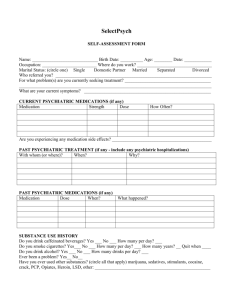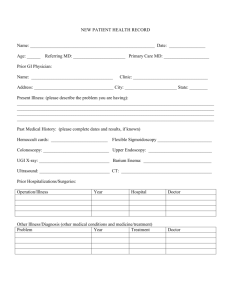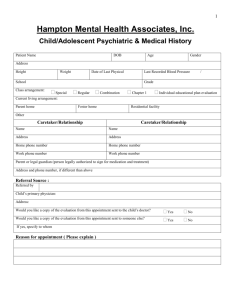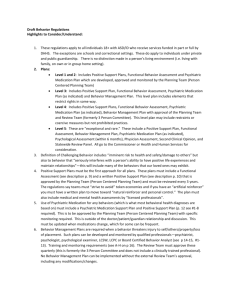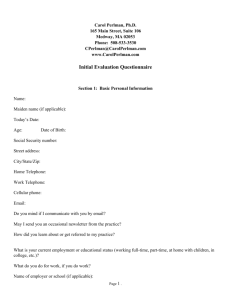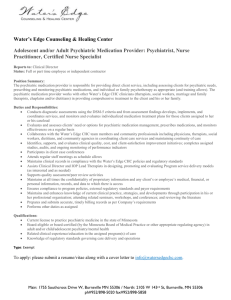psychiatric diagnoses and concomitant drug treatment in the early
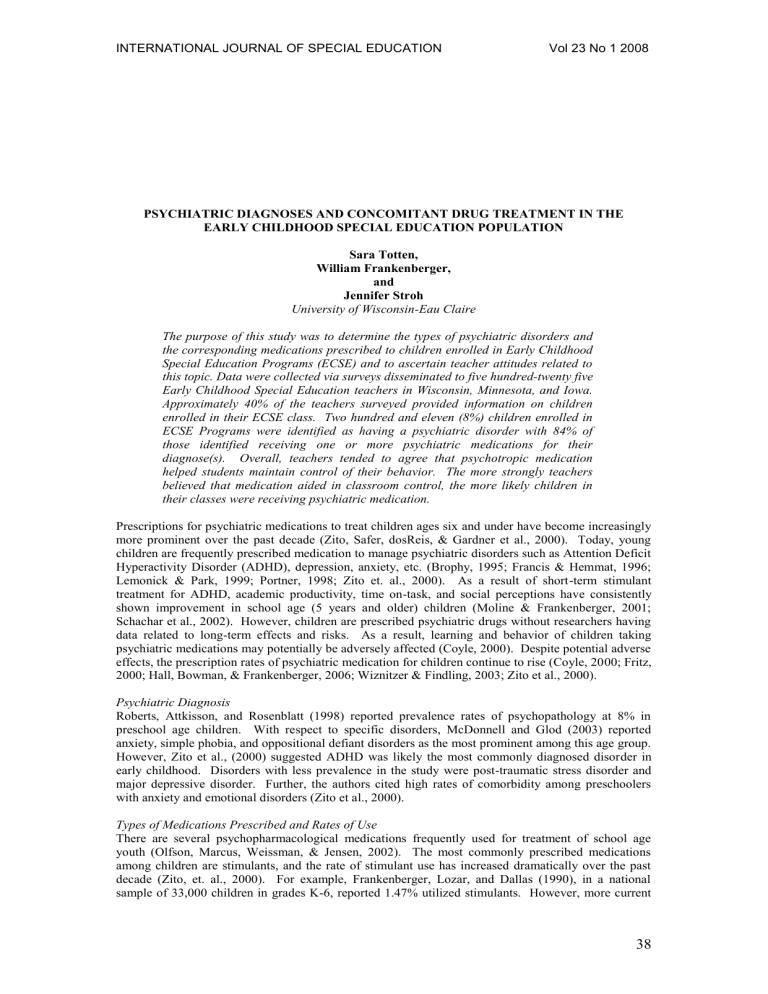
INTERNATIONAL JOURNAL OF SPECIAL EDUCATION Vol 23 No 1 2008
PSYCHIATRIC DIAGNOSES AND CONCOMITANT DRUG TREATMENT IN THE
EARLY CHILDHOOD SPECIAL EDUCATION POPULATION
Sara Totten,
William Frankenberger, and
Jennifer Stroh
University of Wisconsin-Eau Claire
The purpose of this study was to determine the types of psychiatric disorders and the corresponding medications prescribed to children enrolled in Early Childhood
Special Education Programs (ECSE) and to ascertain teacher attitudes related to this topic. Data were collected via surveys disseminated to five hundred-twenty five
Early Childhood Special Education teachers in Wisconsin, Minnesota, and Iowa.
Approximately 40% of the teachers surveyed provided information on children enrolled in their ECSE class. Two hundred and eleven (8%) children enrolled in
ECSE Programs were identified as having a psychiatric disorder with 84% of those identified receiving one or more psychiatric medications for their diagnose(s). Overall, teachers tended to agree that psychotropic medication helped students maintain control of their behavior. The more strongly teachers believed that medication aided in classroom control, the more likely children in their classes were receiving psychiatric medication.
Prescriptions for psychiatric medications to treat children ages six and under have become increasingly more prominent over the past decade (Zito, Safer, dosReis, & Gardner et al., 2000). Today, young children are frequently prescribed medication to manage psychiatric disorders such as Attention Deficit
Hyperactivity Disorder (ADHD), depression, anxiety, etc. (Brophy, 1995; Francis & Hemmat, 1996;
Lemonick & Park, 1999; Portner, 1998; Zito et. al., 2000). As a result of short-term stimulant treatment for ADHD, academic productivity, time on-task, and social perceptions have consistently shown improvement in school age (5 years and older) children (Moline & Frankenberger, 2001;
Schachar et al., 2002). However, children are prescribed psychiatric drugs without researchers having data related to long-term effects and risks. As a result, learning and behavior of children taking psychiatric medications may potentially be adversely affected (Coyle, 2000). Despite potential adverse effects, the prescription rates of psychiatric medication for children continue to rise (Coyle, 2000; Fritz,
2000; Hall, Bowman, & Frankenberger, 2006; Wiznitzer & Findling, 2003; Zito et al., 2000).
Psychiatric Diagnosis
Roberts, Attkisson, and Rosenblatt (1998) reported prevalence rates of psychopathology at 8% in preschool age children. With respect to specific disorders, McDonnell and Glod (2003) reported anxiety, simple phobia, and oppositional defiant disorders as the most prominent among this age group.
However, Zito et al., (2000) suggested ADHD was likely the most commonly diagnosed disorder in early childhood. Disorders with less prevalence in the study were post-traumatic stress disorder and major depressive disorder. Further, the authors cited high rates of comorbidity among preschoolers with anxiety and emotional disorders (Zito et al., 2000).
Types of Medications Prescribed and Rates of Use
There are several psychopharmacological medications frequently used for treatment of school age youth (Olfson, Marcus, Weissman, & Jensen, 2002). The most commonly prescribed medications among children are stimulants, and the rate of stimulant use has increased dramatically over the past decade (Zito, et. al., 2000). For example, Frankenberger, Lozar, and Dallas (1990), in a national sample of 33,000 children in grades K-6, reported 1.47% utilized stimulants. However, more current
38
INTERNATIONAL JOURNAL OF SPECIAL EDUCATION Vol 23 No 1 2008 estimates of stimulant use among students in grades one through five in North Carolina public schools were 7% (Rowland, Sandler, Umbach, Stallone, Bohlig, & Naftel, 2002).
Little direct information is available related to the prevalence of preschool age children treated with stimulant medication. However, Rappley, Eneli, and Mullan et al. (2002) reported that in a group of
223 children diagnosed with ADHD ages three and younger, over half were receiving psychiatric medication. According to Medco (2004), the use of these drugs among preschoolers went up 49% between 2000 and 2003. Zito et al., (2000) stated 3000 prescriptions of fluoxetine hydrochloride
(Zoloft) were written for youth under one year of age in 1994, while Armstrong (2004) reported the rate of antidepressant prescriptions for preschoolers doubled between 1998 and 2002.
There are no known studies addressing the use of multiple prescriptions of psychiatric medication for preschool age children. However, there has been an increase in the prescription of multiple psychiatric medications for school age youth. Safer, Zito, and dosReis (2003) found that approximately 20% of outpatient youth in the 1990s were taking multiple psychiatric medications, while estimates in clinic settings suggest the use of medication combinations at over 50%. Other studies, such as Moline and
Frankenberger (2001), found 21% of secondary students diagnosed with ADHD were taking combinations of medications. Further, Hall, Bowman, & Frankenberger (2006) found, in a sample of
600 elementary students in emotional/behavioral disturbed (EBD) classrooms located in Midwestern schools, 15.1% of children were taking two or more psychiatric medications. Additionally, 6.2% of children in the sample were taking combinations of three or more psychiatric medications.
Issues Related to Medication Treatment with Children
Overall, there is a dearth of research with regard to possible adverse effects of psychiatric medication in preschool age children. However, Safer, Zito, & dosReis (2003) reported that the potential for adverse effects among children younger than nine is considerably higher compared to older children and adolescents. Furthermore, the majority of medication prescribed to young children to treat psychological disorders has not been approved by the FDA (Lemonick & Park, 1999; Portner, 1997;
Sweeney & Forness, 1997). Additionally, the FDA does not evaluate the effects on children who are taking psychiatric medications prior to their prescription, nor does it track the amount of psychiatric medications being prescribed to them (Shogren, 2004).
Studies have demonstrated differences in the neurotransmitter systems of children’s brains, as well as alterations in brain functioning associated with the age and maturation of children receiving psychiatric medication (Wiznitzer & Findling, 2003). Wiznitzer and Findling (2003) also suggested differences in the effectiveness of psychiatric medication to be a result of brain variances in a child’s brain compared to that of an adult. For example, the norepinephrine and dopamine systems continue to develop until adulthood. Consequently, this malleability may explain the difference in efficacy of psychiatric medications such as antidepressants in adults compared to children. Early childhood specifically, includes brain development of areas such as visual processing, language, and motor skill. Moreover, the lack of development in a child’s brain may present enhanced susceptibility to the potential negative effects of psychiatric medication (Fritz, 2000).
Andersen (2005) reported chronic pre-adolescent exposure to stimulant medication altered the expected development of brain structure and function and resulted in a different topography in adulthood. The timing of the exposure and the age of examination along with the sex of the individual influence the observable effects on the brain. Animal studies corroborate these findings. Researchers at Harvard
Medical School (Carlezon & Konradi, 2004) found that two daily injections of methylphenidate in preadolescent rats led to depressive behavior patterns in adulthood. Additionally, they found adult rats previously administered methylphenidate in pre-adolescence were less receptive to “natural rewards”
(i.e. sugar), and hypersensitive to stressful circumstances.
Teacher Attitudes Regarding the Use of Psychiatric Medication
While there is little information on teacher attitudes regarding the use of psychiatric medication with young children (those under five years of age), research has documented teacher support for use of medication with school age children (Glass & Wegar, 2001). Glass and Wegar (2001) reported that teachers tended to believe ADHD was influenced by a child’s environment but their most preferred treatment for students was medication.
39
INTERNATIONAL JOURNAL OF SPECIAL EDUCATION Vol 23 No 1 2008
Further, Epstein, Singh, Luebke, and Stout (1991) found teachers tended to believe hyperactivity, in school aged children, most warranted psychiatric drug treatment. When asked about knowledge of psychiatric drug side effects, 39% of teachers believed there were no negative effects. Finally, 80% of teachers felt they should be involved with the initiation or discontinuation of psychiatric medication, but only 25% reported actually having been consulted occasionally.
Purpose of the Study
Due to the lack of research pertaining to very young children, this study focuses on children enrolled in
Early Childhood Special Education. The purposes of this study were: 1) to determine the psychiatric diagnoses associated with children enrolled in early childhood special education programs, 2) to ascertain the types of medication prescribed for children diagnosed with psychological disorders, and
3) to determine the number of children receiving multiple medications for their diagnosis. Finally, the study investigated the attitudes of teachers with regard to the use of psychiatric medication(s) in children enrolled in early childhood special education programs.
Method
Participants
Subjects for the study included 525 early childhood special education (ECSE) teachers from school districts in the Midwest. States were selected based upon Drug Enforcement Agency (DEA) data from
January to December, 1999. Specifically, selections were made to represent use rates typical for
Midwestern states. DEA data provided amounts of methylphenidate and amphetamine (drugs typically used to treat ADHD) distribution by state. Of the Midwestern states, Minnesota, Iowa, and Wisconsin were noted to have stimulant use rates similar to those of other Midwestern states (Frontline, 2001).
Measure
A four page questionnaire was adapted from that used in the Hall, Bowman, Ley, & Frankenberger
(2006) study. The questionnaire was designed to gather information through a series of Likert-type questions that assessed the teachers’ attitudes about the incidence of childhood psychiatric disorders, and the use of psychiatric medication to treat young children. In addition, the teachers were asked to provide demographic data and information regarding their class size and number of students receiving medication for a psychiatric disorder(s). For each reported student receiving medication, the teachers were asked to supply the type of psychiatric disorder(s) and the particular psychiatric medication(s) administered to treat the corresponding disorder. The survey was designed to be directly comparable to the survey used in the Hall, Bowman, Ley, & Frankenberger (2006) study.
Procedure
ECSE teacher lists were obtained through state educational records departments. The teachers were then randomly assigned a number and 175 of these numbers (teachers) were randomly selected from each of the three states. Teachers were then mailed surveys to complete and return in the envelope provided. The cover letter served as an informed consent. Approximately two weeks later, a second survey was mailed to those who had not yet returned their surveys.
Results
Of the 525 surveys mailed out, 28 were returned not completed because the teachers were no longer teaching early childhood classes. An additional 20 were returned due to invalid mailing addresses, and therefore subtracted from the total number of surveys. Of the remaining 477 surveys, 194 (~ 41%) teachers from Wisconsin (n=81), Iowa (n=32), and Minnesota (n=81) completed questions that included information about 2,659 students enrolled in their early childhood special education classrooms. At the beginning of the survey participants were asked to identify the number of children in their class and the number receiving treatment with psychiatric medication. Nearly 8% (211) of the children in the sample were identified as taking one or more psychiatric medications. The percent of children receiving psychiatric medications by state is presented in Table 1. It should be noted that the rate of medication use for Iowa was much greater than for the other states.
Table 1
Percentage of Students Taking Psychiatric Medication by State
______________________________________________________
State
Iowa
Percentage
16.88
Minnesota
Wisconsin
6.77
6.34
40
INTERNATIONAL JOURNAL OF SPECIAL EDUCATION Vol 23 No 1 2008
Psychiatric Diagnoses of Children Enrolled in Early Childhood Special Education (ECSE) Programs
The second portion of the survey asked participants to provide specific information about the types of psychiatric diagnoses and corresponding medication for individual children in their classroom.
Teachers provided information regarding psychiatric diagnoses for 203 children for this portion of the survey.
For children diagnosed with a psychiatric disorder, Table 2 reveals ADHD was the most common diagnosis (55.2%), followed by Seizure Disorder (16.7%), Anxiety (8.4%), Bipolar (3%), and
Depression (3%). Other low incidence disorders such as Oppositional Defiant Disorder and those not specified accounted for the remaining 36% of the diagnoses. Due to the possibility a child could have more than one disorder, the percentages total more than 100%.
Table 2
Percent of Children Diagnosed with Multiple Psychiatric Disorders
_________________________________________________________
Disorder Number Percentage
ADHD 112 55.2
Seizure Disorder 34 16.7
Anxiety
Bipolar
Depression
Other Low incidence
17
6
8.4
3.0
6 3.0
73 36.0
Note . Percentages include all children that were diagnosed with either a single or multiple disorders.
Of those diagnosed, approximately 22.3% (45) were identified as having two or more psychiatric disorders. The most frequently reported multiple diagnoses were ADHD along with some other disorder which accounted for 13.9% of the 22.3% of children with multiple psychiatric disorders. Other combinations occurred at low frequencies.
Medication Prescribed for ECSE Populations
In the second portion of the survey teachers provided data regarding psychiatric medication for 171 children. Of the 203 children identified as having one or more psychiatric disorders, 84% (171) were identified as receiving one or more psychiatric medication(s).
Table 3
Percent of Diagnosed Children Receiving Psychiatric Medications (by drug class)
____________________________________________________________________
Drug Class Number Percentage
Stimulant
Antiseizure/Mood Stabilizers
Antipsychotic
112
41
24
65.5
24.0
14.0
Antianxiety
Antidepressant
15 8.8
13 7.6
Other Low Incidence 21 12.3
Note . Percentages include all children that were receiving either single or multiple medications.
Table 3 indicates stimulants were the most commonly prescribed medication (65.5%) followed by antiseizure/moodstabilizers (24%), antipsychotics (14%), antianxiety medications (8.8%), and antidepressants (7.6%). Other medications accounted for the remaining 12.3% of those prescribed.
Again, because a child could have been taking more than one type of medication, the percentages total more than 100%.
Of children receiving medication, approximately 32.4% (55) were receiving two or more medications, while 16.4% (28) were receiving three or more medications. Table 4 reveals the most common combination was an antipsychotic along with a stimulant (4.7%), followed by a stimulant and an antiseizure/mood stabilizer (2.3%). The most common three-medication prescription was a stimulant, antipsychotic, and an unknown/other (2.9%).
41
INTERNATIONAL JOURNAL OF SPECIAL EDUCATION Vol 23 No 1 2008
Table 4
Percent of Children on Multiple Psychiatric Medications (by drug class)
-
___________________________________________________________________________________
_
Drug Class
Antipsychotic + Stimulant
Number
8
Stimulant + Antiseizure/mood stabilizer
Antidepressant + Stimulant
Antipsychotic + Antiseizure/mood stabilizer
4
3
3
Percentage
4.7
2.3
1.8
1.8
1.8 Stimulant + Stimulant
Antianxiety + Stimulant
Antiseizure + Antiseizure
Other/not specified
Stimulant + Antipsychotic + other low incidence
Stimulant + Stimulant + other low incidence
Stimulant + Antipsychotic + Antianxiety
3
2
5
2
3
5
3
1.8
1.2
2.9
1.2
2.9
1.8
Antiseizure + other low incidence + other low incidence
Other low incidence/not specified
2
12
1.2
7.0
Total 55 32.4
Note . 14% (24 students) of children were identified as receiving three or more medications.
Teacher Attitudes Regarding the Use of Psychiatric Medication
Early Childhood Special Education (ECSE) teachers were asked to respond to 12 questions that assessed their attitudes/beliefs regarding use of psychiatric medication in children. A Likert (1 to 5) scale was used to indicate teacher responses. Mean and standard deviations were calculated for each question. Answers between 1.00 and 2.00 were labeled as disagree/strongly disagree , those between
2.01 to 2.49 were labeled tendency to disagree , means between 2.50 and 3.49 were labeled neutral , those between 3.50 and 3.99 were labeled tendency to agree , and means between 4.00 and 5.00 were labeled as agree/strongly agree .
Questions 3, 4, and 5 assessed teacher attitudes about whether medication tended to improve academic performance and behavior. Question 3, Medication significantly improves academic performance in young children , elicited a neutral (M=3.41, SD=.864) response. Questions 4 and 5 measured whether the teachers thought medication improved children’s behavior, the mean responses for these questions fell within the tendency to agree range (M=3.69, SD=.846 and M=3.59, SD=.823).
Question 6 evaluated whether teachers were aware when a child had received his/her medication.
Teachers tended to agree they could tell when a child had received his/her medication (M=4.06,
SD=.829). Questions 10 and 11 assessed whether the teachers felt antidepressants and stimulants had few side effects. Answers to these questions fell in the tendency to disagree category (M=2.47,
SD=.814 and M=2.36, SD=.785).
Questions 7 through 9 assessed whether teachers felt medication promoted classroom control. All three questions evoked responses in the neutral range (M=3.32, SD=.953; M=3.48, SD=1.029; and M=3.12,
SD=1.022). Question 13,
Medication tends to change a child’s natural personality
, elicited a mean response of 3.23 (neutral, SD=1.026).
Question 12 evaluated whether teachers were concerned with the long-term impact of medication on children. Teachers’ responses fell within the agree range (M=4.13, SD=.938) on this question.
Question 14, Medication tends to improve a child’s social adjustment , resulted in a mean response of
3.51 (tendency to agree, SD=.790). Finally, a multiple regression was done to determine whether any of the teacher’s responses could predict the number of students in a particular teacher’s class that would be on medication. Question 9, Classroom behavior control would be more difficult for me if children were not treated with prescription medication , was the only significant predictor (accounting for 9% of the variance) of the number of children in a class receiving medication.
42
INTERNATIONAL JOURNAL OF SPECIAL EDUCATION Vol 23 No 1 2008
T able 5
Survey Questions with Means and Standard Deviations
Children and Psychiatric Disorders/Medication Survey
____________________________________________________________________
THE FOLLOWING SCALE WAS USED TO RESPOND TO THE QUESTIONS BELOW:
1 = Strongly disagree 2 =Disagree 3 = Neutral 4 = Agree 5 = Strongly agree
Question N M SD
172 3.41 .864 3. Medication significantly improves academic performance in young children.
4. Medication significantly benefits students in terms of controlling their own behavior.
173 3.69 .846
172 3.59 .823 5. Young children receiving medication behave more appropriately in social situations than they would without medication.
6. I am aware when a child has not taken his/her medication.
7. In my experience, medication has helped maintain classroom control.
8. Behavioral interventions can be as effective as medication for maintaining classroom control.
9. Classroom behavior control would be more difficult for me if children were not treated with prescription medication.
10. I believe that stimulant medication (e.g. Adderall) has few side effects.
11. I believe that antidepressant medication (e.g. Paxil) has few side effects.
12. I am concerned with the long-term impact of medication on children.
13. Medication tends to change a child’s natural personality.
14. Medication tends to improve a child’s social adjustment.
172 4.06 .829
172 3.32 .953
172 3.48 1.029
173 3.12 1.022
171 2.47 .814
168 2.36 .785
175 4.13 .938
172 3.23 1.026
173 3.51 .790
Discussion
The results of the current study are consistent with those of Roberts, Attkisson, and Rosenblatt’s (1998) review of children in the United States and United Kingdom diagnosed with a psychiatric disorder.
Similar to the rate found in this study, results of their study identified 8% of preschool age children in the United States and United Kingdom as having a psychiatric disorder. The results of the current study are also consistent with data reported by McDonnell and Glod (2003) in their review of rates of co-morbidity of psychological disorders among preschool age children. McDonnell and Glod found co-morbidity between ADHD and Conduct Disorder ranged from 20 to 50%, 25% between ADHD and
Anxiety, and up to 40% between ADHD and Oppositional Defiant Disorder (ODD). The current study found that of children with a psychiatric diagnosis, approximately 22% were reported to have two or more diagnoses, with ADHD and another disorder accounting for 13.9% of multiple diagnoses.
Psychiatric Diagnoses of Children Enrolled in ECSE Programs
Attention Deficit Hyperactivity Disorder (ADHD) was the most common disorder found among children enrolled in early childhood special education programs; approximately 55% of children identified with one or more disorders had a diagnosis of ADHD, consistent with Zito, et al.,’s (2000) findings. Seizure disorder was the next most prominent disorder (16.7%), followed by anxiety disorder
(8.4%). Although clear estimates of seizure disorder are not well known among the preschool age population, rates of anxiety disorder among young children average between .3 and 11.5% (McDonnell
& Glod, 2003).
Medication Prescribed for ECSE Populations
Consistent with previous research (Zito, et. al., 2000), stimulants were the most frequent drug prescribed to children in early childhood classes (65% of those taking one or more medications). In light of recent research, the potential risks associated with use of stimulants with young children may be more significant than previously believed. If older children are at risk for side effects such as height and growth suppression, liver damage, and developmental neurological effects as a result of stimulant use, the risk to young children, while unknown, may be substantial (Andersen, 2005; MTA
Cooperative Group, 2004).
Antiseizure/mood stabilizing medication was the next most prevalent medication taken by children in the study (24% of the children receiving medication). The risks and benefits of these medications has also been a topic of debate by researchers. Lawrence (2003) stated that treatment with antiepileptic
43
INTERNATIONAL JOURNAL OF SPECIAL EDUCATION Vol 23 No 1 2008 medication is not recommended for the majority of children who have had only one seizure because of the medication’s tendency to interfere with critical cognitive processes, specifically learning
(Aldenkamp, DeKrom, & Reijs, 2003).
Antipsychotics were the third most commonly prescribed medication, consisting of 14% of those treated with psychiatric medications . Similar to antiseizure medication, anti-psychotics have been associated with sedation and adverse cognitive effects (Posey & McDougle, 2000) in addition to parkinsonian symptoms, tardive dyskinesia, and changes in heart rate and blood pressure (Bower,
1991; McKim, 2003; Posey & McDougle, 2000). More recently the FDA has placed boxed warnings on all atypical antipsychotics, including Abilify, Risperdal, and Zyprexa (Janssen Pharmaceutica Inc.,
2005), citing an increased risk of death in elderly patients. Though the warning pertains to elderly patients, atypical antipsychotics are not approved for use in child populations; however, the current study found them to be the third most commonly prescribed drug for young children.
Finally, the effects of polypharmacy are not well researched, especially with respect to young children
(Safer et al., 2003). Despite this, psychiatric medication is often utilized concomitantly for treatment of one or more psychiatric disorders (Safer et al., 2003; Wagner, 2003; Wilkinson, Taylor, & Holt, 2002).
The current study found that of the children taking psychiatric medication, approximately 32% were taking combinations of two or more. Among the combinations, an antipsychotic-stimulant pairing was most prominent (5%) followed by a stimulant, antipsychotic, and other/not specified grouping (3%).
This finding varies from that of Safer et al. (2003), where methylphenidate and clonidine tended to be the most common combination among youth ages 0-19.
Teacher Attitudes Regarding the Use of Psychiatric Medication
Overall, teachers tended to view medication as an asset to students controlling their own behavior, behaving more appropriately in social situations, and improving students’ overall social adjustment.
Further, teacher attitudes with regard to medication’s effectiveness on behavioral control significantly predicted whether a teacher’s class would have one or more children in the class taking medication.
Specifically, if a teacher held the belief that medication significantly improved classroom control, the more likely students in his/her class would be taking medication. Another potential explanation is that as teachers become more familiar with possible advantageous effects of medication, they may be more likely to recommend the same line of treatment for other children in their classroom.
Alternatively, teachers in the current study tended to indicate concern with regard to side effects and long-term impact of medication in children. This finding is in concordance with earlier findings by
Epstein, Singh, Luebke, and Stout (1991) who found that teachers did not feel they had adequate training with respect to side effects and/or general knowledge of psycho-pharmacotherapy for children with learning disabilities/behavioral issues. Teachers in the Epstein, Singh, Luebke, and Stout (1991) study further stated a need for more school personnel to be involved with tracking changes and effects of medication in children.
Implications
The current study raises concern about the number of young children taking single and multiple doses of psychiatric medication(s). In the current study, the percentage of preschool age children taking psychiatric medication approached that of pre-adolescent and adolescents reported by Roberts,
Attkisson, and Rosenblatt (1998). More importantly, the study raises concern about the long and short term effects these medications may have on young children. Short-term side effects for adults and older children have been well documented (Boyles, 2005; Frankenberger and Cannon, 1999; McKim,
2003; Moline and Frankenberger, 2001; Sweeney and Forness, 1997); however, it is unclear if these side-effects are the same as those experienced by young children. Additionally, long-term side-effects are not well understood for children and the impact of psychiatric medication on learning and the developing brain has yet to be well defined, but recent research indicates reason for concern (Andersen,
2005; Mazer et al., 1997; MTA, 2004; Warden et al., 2005).
Finally, there is mixed evidence surrounding the effectiveness of psychiatric medication, especially among young children (Rappley et al., 2002). For example, while stimulants appear to improve time on task and academic productivity, it is not clear whether they improve overall learning and long term achievement (Frankenberger & Cannon, 1999; Sinha, G., 2005). Further, the effects of behavioral interventions have been investigated and found to be equivalent to stimulant medication in some studies (Klingberg, Fernell, Olesen, Johnson, Gustafsson, et al., 2005; MTA, 2004), yet stimulants
44
INTERNATIONAL JOURNAL OF SPECIAL EDUCATION Vol 23 No 1 2008 seem to be the first line of treatment for children diagnosed with ADHD. Similarly, effectiveness of other psychiatric medication such as anti-psychotics and antidepressants has not been well established with respect to their efficacy among young children. However, behavioral interventions for disorders that would be treated by the psychiatric medication delineated above have been proven effective for disorders such as ADHD, anxiety and those characterized with aggressive behavior (Fisher, Gunnar,
Chamberlain, & Reid, 2000; Klingberg et al., 2005; Lochman & Wells, 2003; Masia, Klein, & Storch,
2001) without risk of side effects.
Many studies have documented the short-term efficacy of psychiatric medication for adults (Brown
University, 2005; Dodson, 2005; Eli Lilly, 2004); however the same level of proof is generally not available for children. Further, studies typically lack long-term data concerning effects for any population. Given the uncertainty of long-term effects and risks, it is reasonable to question the rapid increase of psychiatric drug use with young children. However, the increase seems to be generally accepted without corroborative evidence. Therefore, use of psychiatric drugs with children, especially young children, warrants monitoring. Additionally, moderation may be a more wise approach as the evidence supporting the use of psychiatric medication with school-aged children remains tenuous
(Kollins, Barkley, & DuPaul, 2001). Finally, reserving treatment with psychiatric medication for only the most severe cases in early childhood may be more appropriate until conclusive research of psychiatric medication’s short and long-term effects in this age group is demonstrated.
Limitations
The response rate for the current study was approximately 41%; therefore it is possible that those who responded were not representative of the original sample. However, the response rate may have been reduced because the survey asked questions about information that teachers may not have known, or required further research. Further, it is possible the results may not be completely accurate as many children may take their medication at home prior to coming to school (Manos, Short, & Findling,
1999), therefore teachers may be unaware of whether a child is taking psychiatric mediction(s).
However, the findings of the current study are consistent with those of Roberts, Attkisson, and
Rosenblatt’s (1998).
Future research could include similar studies for the East and West coasts to determine if the results of the current study are consistent with potential findings in these areas.
References
Aldenkamp, A. P., De Krom, M., & Reijs, R. (2003). Newer antiepileptic drugs and cognitive issues.
Epilepsia, 44, 21-29.
Andersen, S. (2005). Stimulants and the developing brain. Trends in Pharmacological Sciences,26,
237-243.
Armstrong, E. (Apr/2004). Debate grows over antidepressant use among preschoolers.
The Christian
Science Monitor. Retrieved June 14, 2004. http://www.csmonitor.com/2004/0408/p01s03-ussc.htm
Bower, B. (1991). Anti-psychotics evoke youthful concerns. Science News, 140, 276.
Boyles, S. (Mar. 2005). Does Ritalin increase cancer risk in children? WebMD retrieved March 2,
2005 from http://www.foxnews.com
Brophy, B. (1995, November).Kindergartners in the Prozac nation. U.S. News & World Report, 119,
96-98.
Brown University (2005). Methylphenidate for adult ADHD. Brown University Psychopharmacology
Update, 16, 5.
Carlezon Jr., W. A. & Konradi, C. (2004). Understanding the neurobiological consequences of early exposure to psychotropic drugs: linking behavior with molecules. Neuropharmacology, 47, 47-60.
Coyle, J. T. (2000). Psychiatric drug use in very young children. JAMA, 283, 1059-1061.
Dodson, W. W. (2005). Pharmacotherapy of adult ADHD. Journal of Clinical Psychology, 61, 589-
607.
Eli Lilly (2004). New treatment sanctioned for adult depression. Nurse Practitioner,29, 70.
Epstein, M.H., Singh, N.N., Luebke, J., & Stout, C.E. (1991). Psychopharmacological intervention II:
Teacher perceptions of psychiatric medication for students with learning disabilities. Journal of
Learning Disabilities, 24, 477-483.
Fisher, P. A., Gunnar, M. R., Chamberlain, P., & Reid, J. B. (2000). Preventive Intervention for maltreated preschool children: Impact on children’s behavior, neuroendocrine activity, and foster parent functioning. Journal of the American Academy of Child and Adolescent Psychiatry, 39, 1356-
64.
45
INTERNATIONAL JOURNAL OF SPECIAL EDUCATION Vol 23 No 1 2008
Francis, E. E. & Hemmat, J. P. (1996). Who dispenses pharmaceuticals to children at school? Journal of School Health, 66, 355-359.
Frankenberger, W., Lozar, B., & Dallas, P. (1990). The use of stimulant medication to treat attentiondeficit hyperactivity disorder in elementary school children. Developmental Disabilities Bulletin, 18,
1-13.
Frankenberger, W., & Cannon, C. (1999). Effects of ritalin on academic achievement from first to fifth grade. International Journal of Disability, Development on Education, 46, 199-221.
Fritz, G. K. (May/2000). Let’s explore the ‘why’ of prescribing psychiatric medications to preschoolers. Brown University Child & Adolescent Behavior Letter, 16, 8.
Frontline. (2001). Statistics on stimulant use: production levels. Retrieved June 10, 2004 from http://www.pbs.org/wgbh/pages/frontline/shows/medicating/drugs/stats.html
Glass, C. S. & Wegar, K. (2001). Teacher perceptions of the incidence and management of attention deficit hyperactivity disorder. Education, 121, 412-420.
Hall, K., Bowman, K., Ley, K., & Frankenberger, W. (2006). Comorbid diagnosis and concomitant medical treatment for children with emotional and behavioral disabilities. International
Journal of Special Education, 21, 96-107 .
Janssen Pharmaceutica Inc. (May 2005). Important drug warning. (consumer letter)
Klingberg, T., Fernell, E., Olesen, P. J., Johnson, M., Gustafsson, P., Dahlstrom, K., Gillberg, C. G.,
Forssberg, H., & Westerberg, H. (2005). Computerized training of working memory in children with
ADHD-A randomized, controlled trial. Journal of the American Academy of Child and Adolescent
Psychiatry, 44, 177-186.
Kollins, S. H., Barkley, R. A., & DuPaul, G. J. (2001). Use and management of medications for children diagnosed with attention deficit hyperactivity disorder. Focus on Exceptional Children, 33,
23-28.
Lawrence, D. (Feb. 8, 2003). Don’t treat a child’s first seizure with antiepileptics, says expert panel.
Lancet, 361, (9356).
Lemonick, M. D. & Park, A. (1999, May). Beyond Depression. Time, 153, 74.
Lochman, J. E. & Wells, K. C. (2003). Effectiveness of the coping power program and of classroom intervention with aggressive children: Outcomes at a 1-year follow up. Behavior Therapy, 34, 493-
515.
Manos, M. J., Short, E. J., & Findling, R. L. (1999). The differential effectiveness of Methylphenidate and adderall in school-age youths with attention-deficit/hyperactivity disorder. Journal of the
American Academy of Child and Adolescent Psychiatry, 38, 813-819.
Masia, C. L., Klein, R. G., & Storch, E. A. (2001). School-based behavioral treatment for social anxiety disorder in adolescents. Journal of American Academy of Child and Adolescent Psychiatry, 40,
780-786.
Mazer, C., Muneyyirci, J., Taheny, K., Raio, N., Borella, A., & Whitaker-Azmitia, P. M.(1997).
Serotonin depletion during synaptogenesis leads to decreased synaptic density and learning deficits in the adult rat. A model of neurodevelopmental disorders with cognitive deficits. Brain Resources, 760,
68-73.
Medco (May 14, 2004). Articles on pharmacy benefit management: Medco says pediatric drug costs soar, driven by ADHD, Depression. Drug Cost ManagementReport.
Retrieved June 23, 2005 from:
Http://www.aishealth.com/DrugCosts/DCMRMedcoPediatricCosts.html
McDonnell, M. A., & Glod, C. (2003). Prevalence of psychopathology in preschool-age children.
Journal of Child and Adolescent Psychiatric Nursing, 16, 141-152.
McKim, W. A. (2003). Drugs and behavior: An introduction to behavioral pharmacology, (5 th ed.) .
New Jersey: Prentice Hall.
Moline, S. & Frankenberger, W. (2001). Use of stimulant medication for treatment of attentiondeficit/hyperactivity disorder: A survey of middle and high school students’ attitudes. Psychology in the Schools, 38, 569-584.
MTA Cooperative Group (2004). National institute of mental health multimodal treatment study of
ADHD follow up: Changes in effectiveness and growth after the end of treatment. Pediatrics, 113,
762-770.
Olfson, M., Marcus, S. C., Weissman, M. M., & Jensen, P. S. (2002). National trends in the use of psychiatric medications by children. Journal of the American Academy of Child and Adolescent
Psychiatry, 41, 514-521.
Portner, J. (1997). Anti-depressants for children: Aids to learning or quick fixes? Education Week, 17 ,
1-3.
Portner, J. (1998, January). Drug therapy. Teacher Magazine, 9, 10-12.
46
INTERNATIONAL JOURNAL OF SPECIAL EDUCATION Vol 23 No 1 2008
Posey, D. J. & McDougle, C. J. (2000). The pharmacotherapy of target symptoms associated with autistic disorder and other pervasive developmental disorders.
Harvard Review of Psychiatry, 8, 45-64.
Rappley, M.D., Eneli, I. U., Mullan, P. B., Alvarez, F. J., Wang, J., Luo, Z., & Gardiner, J. C. (2002).
Patterns of psychiatric medication use in very young children with attention-deficit hyperactivity disorder. Journal of Developmental and Behavioral Pediatrics, 23, 23-30.
Roberts, R.E., Attkisson, C., & Rosenblatt, A. (1998). Prevalence of psychopathology among children and adolescents. American Journal of Psychiatry, 155, 715-725.
Rowland, A. S., Sandler, D. P., Umbach, D. M., Stallone, L., Bohlig, M. E., Naftel, J. A. (2002).
Prevalence of medication treatment for attention deficit—Hyperactivity disorder among elementary school children in Johnston County, North Carolina. American Journal of Public Health, 92, 231-235.
Safer, D. J., Zito, J. M., & dosReis, S. (2003). Concomitant psychiatric medication for youths.
American Journal of Psychiatry, 160, 438-449.
Schachar, R., Jadad, A. R., Gauld, M., Boyle, M., Booker, L., Snider, A., Kim, M., & Cunningham, C.
(2002). Attention-deficit hyperactivity disorder: Critical appraisal of extended treatment. Canadian
Journal of Psychiatry, 47, 337-349.
Shogren, E. (Mar/2004). Warning slated for antidepressants. St. Paul Pioneer Press.
Sinha, G. (2005). Training the brain. Scientific American, 293, 22-24 .
Sweeney, D. P., Forness, S. R. (1997). An update of psychopharmacologic medication: What teachers, clinicians, and parents need to know. Intervention in School and Clinic, 3 , 4-22.
Warden, S. J., Robling, A. G., Sanders, M. S., Bliziotes, M. M., & Turner, C. H. (2005). Inhibition of the serotonin transporter (5-HTT) reduces bone accrual during growth. Endocrinology, 146, 685-693.
Wilkinson, G. B., Taylor, P., & Holt, J. R. (2002). Bipolar disorder in adolescence: Diagnosis and treatment. Journal of Mental Health Counseling, 24, 348-358.
Wiznitzer, M., & Findling, R. L. (2003). Why do psychiatric drug research in children? Lancet, 361,
1147-1149.
Zito, J. M., Safer, D. J., dosReis, S., & Gardner, J. F. et al.. (2000). Trends in the prescribing of psychiatric medications to preschoolers. JAMA, 283, 1025-1031.
47
